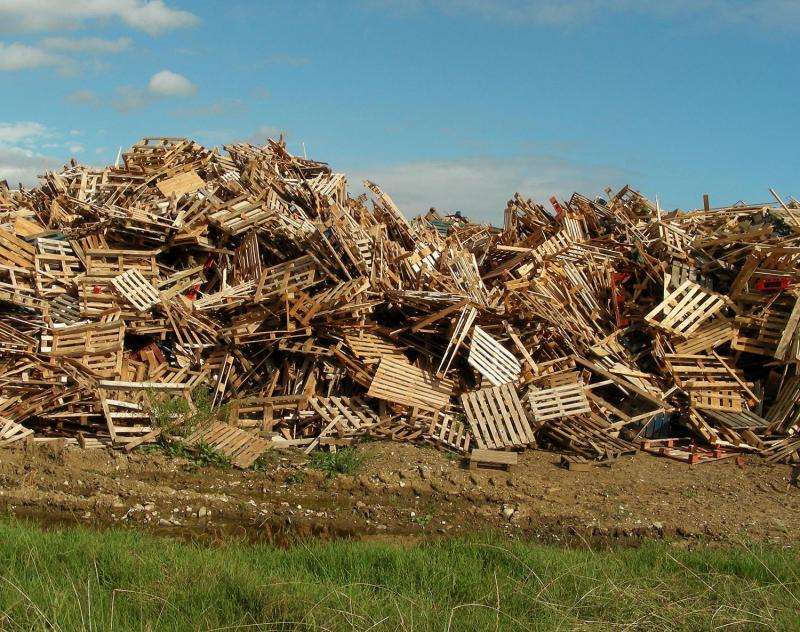Generating energy from used wood

Switzerland is not fully exploiting a significant source of clean energy: 173,000 tonnes of used wood could be re-used producing valuable heat and power energy today, in addition to the 644,000 tonnes of used wood already being used. This was the conclusion reached by a nationwide survey conducted by the Swiss Federal Research Institute for Forest, Snow and Landscape Research (WSL) among 567 companies in the construction, waste management and transport sectors.
Nearly 1 million tonnes of used wood, i.e. wood accumulated on construction or demolition sites, arising from building renovations or conversions or in the form of packaging or crushed wood waste, were produced in Switzerland in 2014. Sustainable energy could have been generated out of 817,000 tonnes of this wood, but only 644,000 tonnes of used wood were actually used producing heat or electricity. The additional used wood available would suffice to supply heat, at 80% efficiency, to some 80,000 average households during the cold season (from September to May) and provide enough power for 40,000 average homes.
These data are based on a hitherto unprecedented nationwide survey in Switzerland of 567 businesses that collect, transport and/or dispose used wood. A team of WSL researchers led by Oliver Thees ascertained how much disused wood accrued in 2014 in all regions of Switzerland and which quantities were used in order to produce energy, were disposed of or were sold abroad. In a just published report2, the authors explain how much potential there is to gain energy from used wood and how the utilisation of this raw material could develop in the future.
Opportunities for higher regional power production
Based on the survey's results, the researchers compiled a robust database that reveals detailed information about the regional and nationwide build-up and utilisation of wood which has already been used. According to their findings, the canton of Bern has the greatest potential for sustainably re-using wood to generate energy. However, so much used wood is already converted into heat and electricity there that the current total could only be increased by 7%. The greatest quantities, in absolute terms, of additional used wood that could be exploited as an energy source are produced in these cantons: Basel Land (a potential increase of 95%), St. Gallen (43%), Solothurn (38%), Lucerne (27%) and Zurich (13%). "Energy production from used wood in these cantons could have been markedly increased in 2014, the year covered by the survey", says project team member Matthias Erni. Current, regionally differentiated data from the survey suggest that the aforementioned types of company could draw on the researchers' findings to plan their resource management.
Using more used wood in Switzerland increases value added
Although there is sufficient interest in the energy use of wood which has already been used in Switzerland, in 2014 roughly one-third of the used wood was exported. The wood's end users process it into particle board or use it to generate energy. Yet if more used wood in Switzerland was re-used to produce heat or power, this would eliminate the need for numerous shipments of timber abroad, which would save energy, lower costs and cut emissions of greenhouse gases. Moreover, since used wood is already in short supply today, it seems only sensible to fully exploit any remaining usable potential and, as a contribution to the energy revolution, enable the generation of higher value added in Switzerland by making use of used wood.
Used wood is a sought-after commodity that accrues when wood products have reached the end of their useful life. Most of it stems from construction or demolition sites, building renovations and conversions and from packaging and crushed waste whose pollutant content falls within the permitted guidelines for recycling or wood combustion (OMW, 2005). However companies seem to interpret used wood' as meaning all wood that has already been used once (Murer 2015), which also includes problematic wood waste and bulky waste wood. The aforementioned study also uses the term used wood' in this sense.
Mindful of the energy revolution, the Swiss Competence Center for Energy Research (SCCER) in the biomass sector (BIOSWEET, or BIOmass for SWiss EnErgy fuTure) would like to see biomass make a larger contribution to Switzerland's energy supply. In this connection, the WSL is examining lignified and non-lignified biomass resources and their potential for the energy use. Used wood is one such resource.
Provided by Swiss Federal Institute for Forest, Snow and Landscape Research WSL


















